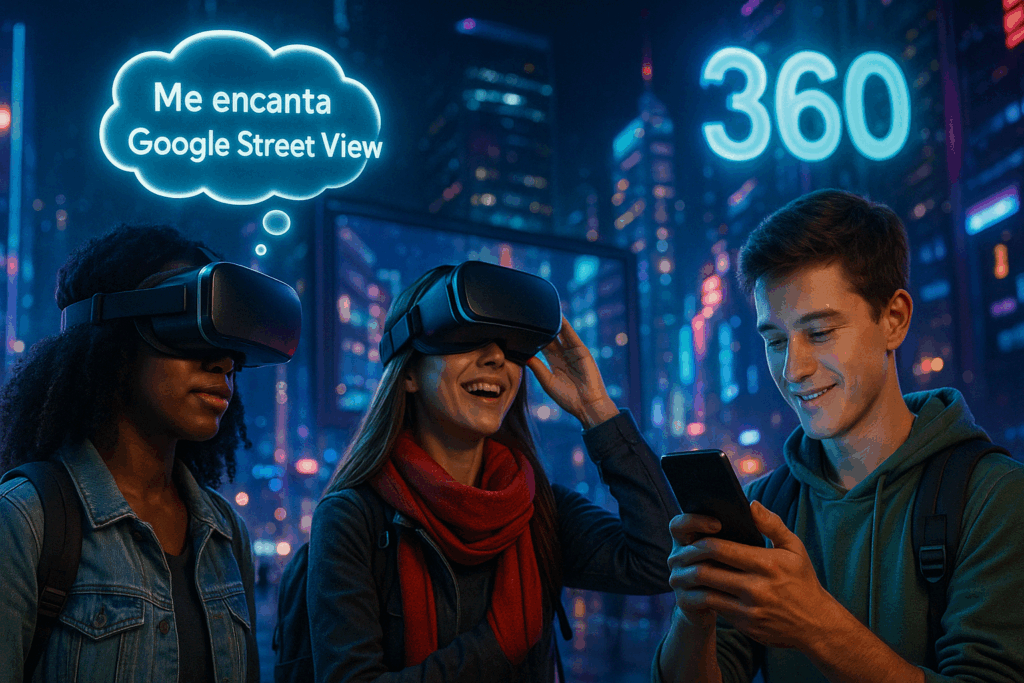This article explores the latest trends in virtual tours for 2025 and the technologies that are revolutionizing the way we experience different places. Many people can now visit museums, parks, and cities without leaving their homes. It also discusses the advantages of these tours, such as their accessibility for everyone and the opportunity to learn new things in an interactive way.
What are Virtual Tours?
The virtual tours 2025 are digital experiences that allow users to explore places or environments without needing to be physically present. Using technologies such as virtual reality and 360-degree photography, these tours offer a total immersion, allowing people to navigate through spaces such as museums, historic buildings, parks, or even properties for sale. For example, a virtual tour of a museum can include interactive descriptions of works of art and the ability to zoom in on details, all from the comfort of their own home. This not only makes it easier to access places that might be difficult to visit, but also enriches the user experience by providing additional information and unique perspectives.
Virtual Tour Trends in 2025
By 2025, virtual tours will evolve to become even more immersive and accessible. augmented reality (AR) and virtual reality (VR) will integrate more seamlessly, allowing users to experience three-dimensional environments that feel almost tangible. For example, in the travel industry, travelers will be able to explore famous destinations from their homes, interacting with elements of the environment as if they were there in person.
In addition, personalization will play a crucial role. Platforms will offer tours tailored to individual interests and preferences, creating unique experiences for each user. For example, a museum tour could highlight specific works of art based on the visitor's viewing history.
Artificial intelligence (AI) will also transform the way tours are created and presented. Virtual assistants will be able to guide users in real time, providing additional information and answering questions about what they're seeing. These improvements will not only make tours more informative, but also more interactive and entertaining.
Finally, sustainability will be a key focus. With increasing environmental awareness, companies in 2025 will seek to create tours that are not only engaging but also promote sustainable destinations and responsible practices. This could include focusing on how visitors can contribute to environmental conservation while exploring.
Benefits of Virtual Tours

Virtual tours offer multiple benefits that transform the way we interact with spaces and products. First, they allow users to explore places from the comfort of their homes, eliminating geographical barriers. For example, a person in Spain can visit an art gallery in New York without having to travel. Furthermore, these tours are accessible at any time, meaning they are not limited by opening hours.
Another important benefit is the ability to attract a wider audience. Companies and businesses can showcase their facilities to potential customers who might not otherwise have the opportunity to visit them. For example, hotels and resorts can create virtual tours so travelers can view rooms and amenities before booking. This not only improves the customer experience but can also increase conversion rates.
Virtual tours are also effective marketing tools. They allow for immersive storytelling, capturing the viewer's attention. By including interactive elements, such as informational hotspots, users can gain additional insights into what they're seeing, enriching their experience. In short, virtual tours 2025 are not only innovative but also offer significant practical and commercial advantages.
- They increase the visibility of your business.
- They offer an immersive customer experience.
- They reduce marketing and promotion costs.
- They facilitate access to a global audience.
- Improve customer retention.
- They allow a dynamic presentation of products.
- Increase user engagement.
How to Create an Engaging Virtual Tour 2025
To create an engaging virtual tour, it is essential to focus on the user experienceFirst, choose a theme that resonates with your audience. For example, if you're promoting an art gallery, highlight the most striking works and provide interesting information about each piece. Use high-quality images and make sure navigation is intuitive.
Incorpora interactive elements, such as quizzes or surveys, that keep visitors engaged. Also, consider adding audio narration or descriptions to bring the experience to life.
A good example is a virtual tour of a national park, where users can explore trails and watch videos of local wildlife. This not only educates but also inspires visitors to plan a physical visit. Don't forget to optimize the tour for mobile devices, as many users will access it from their phones.
Examples of successful Virtual Tours
The virtual tours have proven to be a powerful tool in various industries. A prominent example is the Louvre Museum in Paris, which offers virtual tours of its galleries, allowing users to explore masterpieces like the Mona Lisa from the comfort of their homes.
Another successful case is that of the real estate company Zillow, which uses 3D virtual tours to showcase properties, giving buyers a clearer and more detailed view of the properties without having to physically visit them. Additionally, Harvard University has implemented virtual tours of its campus, allowing prospective students to experience the facilities and academic environment before making a decision. These examples not only highlight the versatility of virtual tours, but also their ability to improve the quality of life of the students. user experience in different contexts.
Technology behind Virtual Tours
Virtual tours are supported by several technologies that allow for the creation of immersive and engaging experiences. One of the most important is virtual reality (VR), which uses devices such as VR headsets to transport the user into a three-dimensional environment. In addition, the augmented reality (AR) combines digital elements with the real world, allowing users to interact with virtual objects superimposed on their physical environment.
Another key aspect is 360-degree capture, which uses special cameras to record panoramic images and videos, providing a complete view of the space. alavista.mx We use platforms like Matterport and Street View, allowing users to explore places intuitively.
Likewise, the 3D modeling technology It's essential. With software like Blender or SketchUp, detailed representations of buildings and spaces can be created, which are then integrated into virtual tours 2025. Interactions, such as clicking to obtain additional information, are designed through simple programming, which improves the user experience.
By 2025, these technologies are expected to continue evolving, incorporating artificial intelligence to personalize experiences and make them more interactive. For example, a virtual tour could adapt the information displayed based on the user's interests, making each visit unique.
How to integrate virtual tours into your business
Integrating virtual tours into your business can transform the way you interact with your customers. First, assess your company's needs and how a virtual tour can add value. For example, if you own a real estate agency, a virtual tour of your properties will allow potential buyers to explore the spaces without having to travel.
Once you've identified the opportunities, select the right platform that fits your budget and technical requirements. Options like Matterport and Kuula offer intuitive tools for creating quality tours. Also, make sure your virtual tour is accessible on mobile devices, as many users will be viewing it on their phones.
Promotion is key. Share your virtual tour on social media and your website to increase its visibility. You can also use emails to invite your customers to experience the tour, creating a closer bond with them. Finally, don't forget to collect feedback. This will help you improve and adapt to your users' needs.
Tips for promoting your Virtual Tour

To get your virtual tour to a wide audience, it's essential to employ various promotional strategies. First, use social media to share engaging content. Post short videos or eye-catching images that showcase the highlights of your tour. Don't forget to use relevant hashtags to increase visibility.
Also, consider collaborate with influencers in your sector. They can help spread the word about your tour to a wider audience and increase the credibility of your offering. You can also create email marketing campaigns, sending newsletters that include links to your virtual tour and special promotions.
Another effective technique is to optimize your website for SEO. Be sure to include keywords related to virtual tours in your descriptions and titles. This will help more people find you through search engines.
Finally, don't underestimate the power of visual content. Creating an engaging trailer or tour preview can capture the attention of potential visitors. Always remember to measure the results of your campaigns to adjust your strategies and achieve greater impact.
Frequently Asked Questions
1. What are virtual tours and how will they work in 2025?
Virtual tours are online experiences that allow you to explore places and spaces in 3D from your computer or mobile device. By 2025, they are expected to become even more immersive thanks to improvements in technology.
2. What types of places can be visited through virtual tours?
You can visit museums, historical sites, natural parks, and even real estate properties. These tours are ideal for exploring new places without leaving home.
3. Do I need special equipment to take a virtual tour?
Typically, you only need a computer or mobile device with an internet connection. Some tours can be enhanced with virtual reality headsets, but they are not required.
4. Are the virtual tours interactive or just visual?
Many virtual tours are interactive, meaning you can click on different areas to learn more or view additional content, making the experience more enriching.
5. Can I enjoy virtual tours in a group or with friends?
Yes, many virtual tours allow you to share the experience with others, either through links or by integrating video conferencing tools to enjoy together.
TL;DR Virtual Tours 2025 are becoming an essential tool for businesses in 2025, offering immersion and accessibility. Emerging trends include augmented reality and interactive tours. Their benefits range from improving the customer experience to increasing sales. Visual design and storytelling are key to creating an engaging tour. Successful examples demonstrate their effectiveness, supported by technologies like virtual reality. Integrating them into your business and choosing the right platform are crucial steps, as is promoting them effectively. The future of Virtual Tours is bright.
















